ECON08005 Global Macroeconomic Policies: Fiscal Policy Instruments
VerifiedAdded on 2023/06/18
|10
|2666
|268
Essay
AI Summary
This essay provides a comprehensive analysis of global macroeconomic policies, focusing on the implementation and impact of monetary and fiscal policies on GDP and price levels. It begins by explaining how these policies are implemented, with specific examples from the UK, and how they can be used to influence economic growth and stability. The essay details the roles of central banks in managing money supply, interest rates, and reserve requirements, and how these actions affect aggregate demand and supply. Furthermore, it assesses the potential of fiscal policy as a key instrument in the UK's future economic strategy, particularly in the context of post-pandemic recovery. The analysis considers both expansionary and contractionary fiscal policies, their potential benefits and drawbacks, and their overall effectiveness in achieving macroeconomic stability and sustainable development. The document is available on Desklib, a platform offering a wide array of study tools and resources for students.
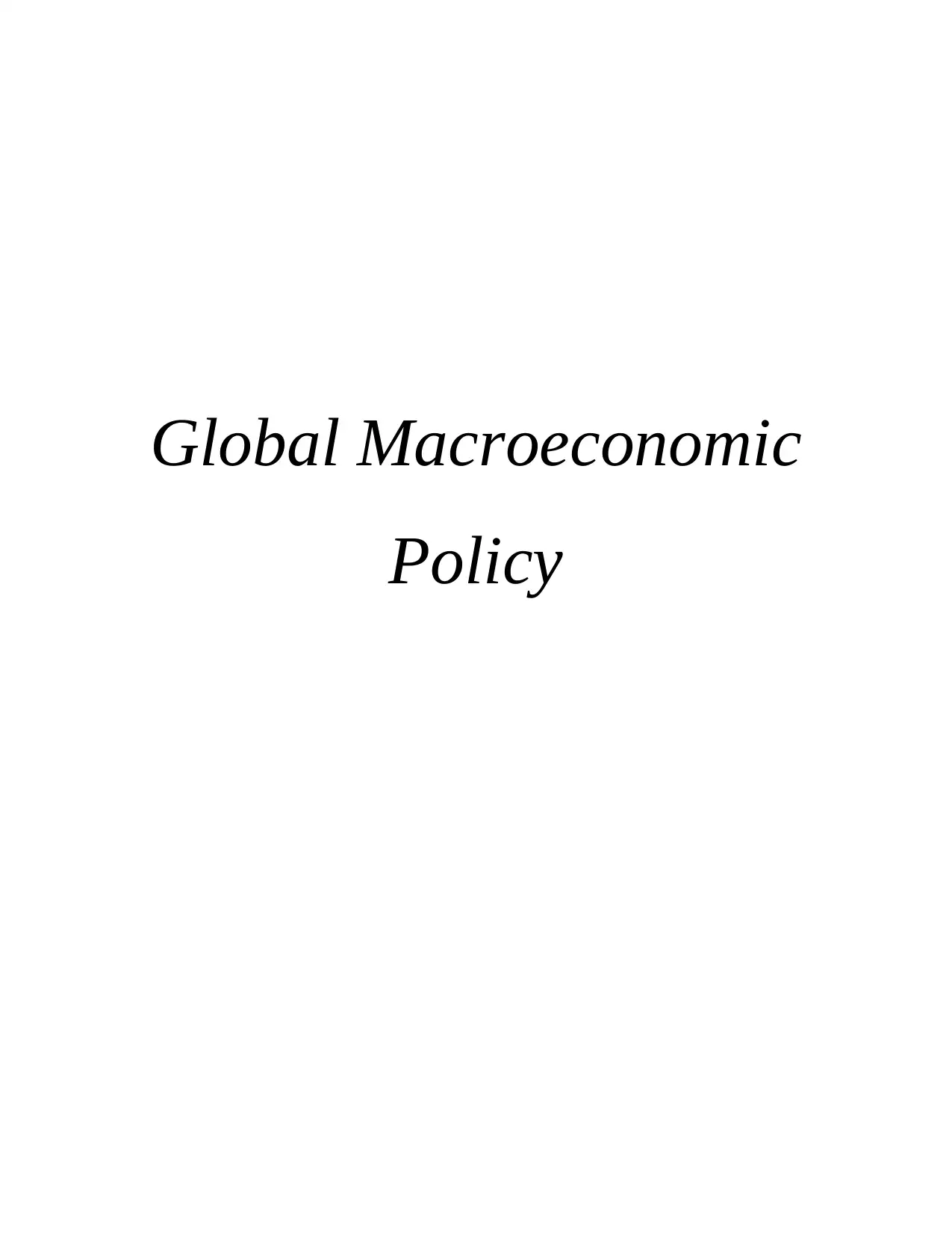
Global Macroeconomic
Policy
Policy
Paraphrase This Document
Need a fresh take? Get an instant paraphrase of this document with our AI Paraphraser
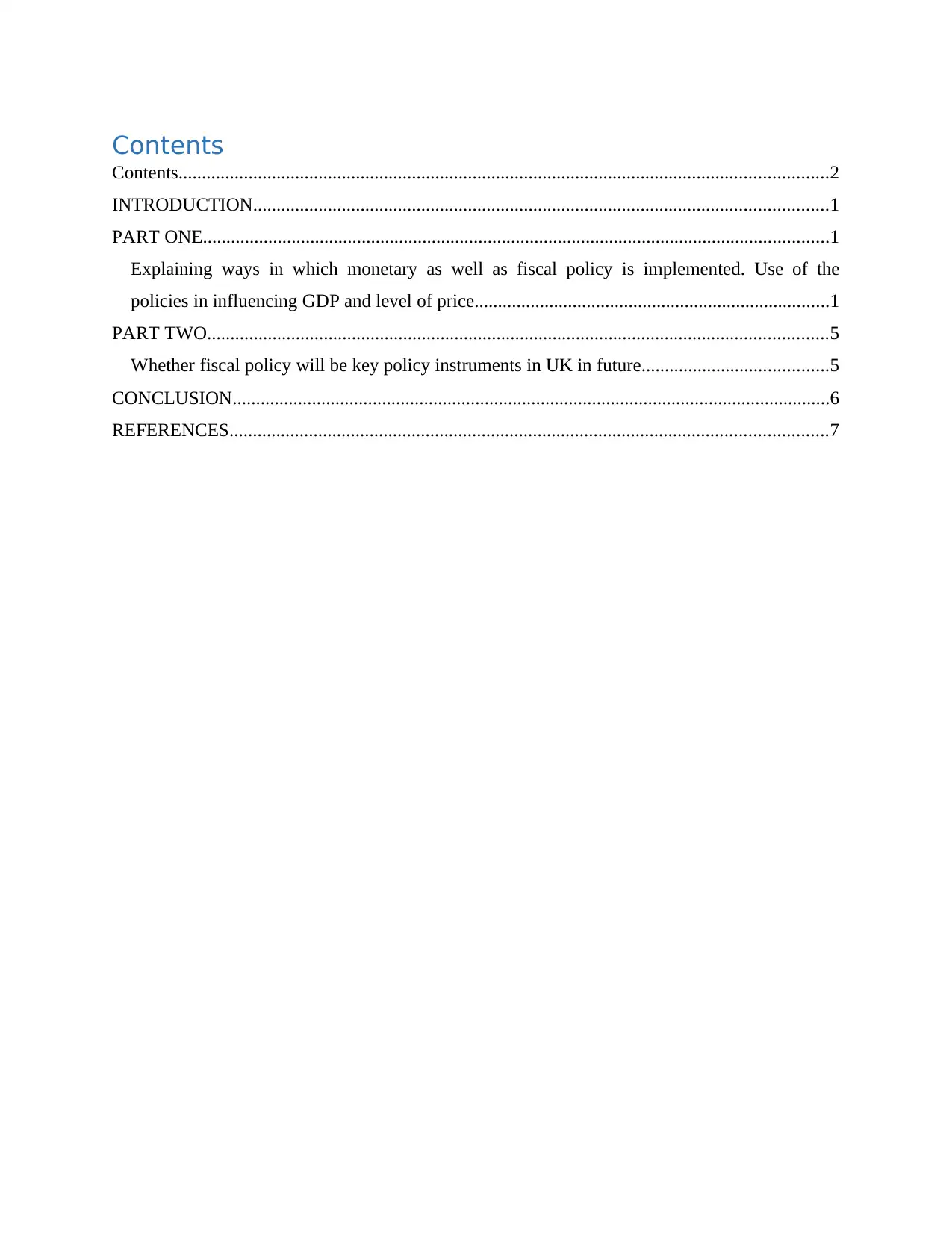
Contents
Contents...........................................................................................................................................2
INTRODUCTION...........................................................................................................................1
PART ONE......................................................................................................................................1
Explaining ways in which monetary as well as fiscal policy is implemented. Use of the
policies in influencing GDP and level of price............................................................................1
PART TWO.....................................................................................................................................5
Whether fiscal policy will be key policy instruments in UK in future........................................5
CONCLUSION................................................................................................................................6
REFERENCES................................................................................................................................7
Contents...........................................................................................................................................2
INTRODUCTION...........................................................................................................................1
PART ONE......................................................................................................................................1
Explaining ways in which monetary as well as fiscal policy is implemented. Use of the
policies in influencing GDP and level of price............................................................................1
PART TWO.....................................................................................................................................5
Whether fiscal policy will be key policy instruments in UK in future........................................5
CONCLUSION................................................................................................................................6
REFERENCES................................................................................................................................7

⊘ This is a preview!⊘
Do you want full access?
Subscribe today to unlock all pages.

Trusted by 1+ million students worldwide
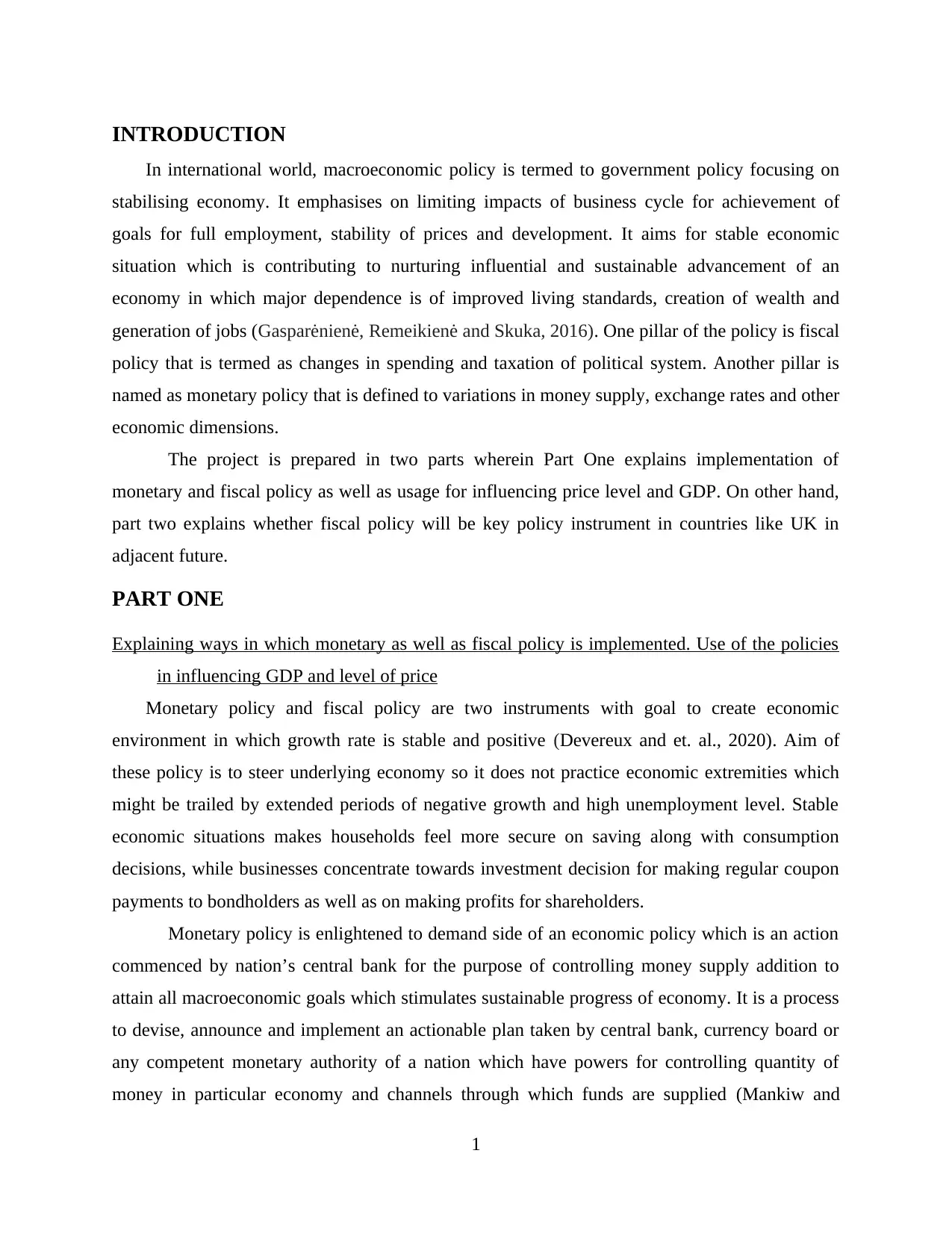
INTRODUCTION
In international world, macroeconomic policy is termed to government policy focusing on
stabilising economy. It emphasises on limiting impacts of business cycle for achievement of
goals for full employment, stability of prices and development. It aims for stable economic
situation which is contributing to nurturing influential and sustainable advancement of an
economy in which major dependence is of improved living standards, creation of wealth and
generation of jobs (Gasparėnienė, Remeikienė and Skuka, 2016). One pillar of the policy is fiscal
policy that is termed as changes in spending and taxation of political system. Another pillar is
named as monetary policy that is defined to variations in money supply, exchange rates and other
economic dimensions.
The project is prepared in two parts wherein Part One explains implementation of
monetary and fiscal policy as well as usage for influencing price level and GDP. On other hand,
part two explains whether fiscal policy will be key policy instrument in countries like UK in
adjacent future.
PART ONE
Explaining ways in which monetary as well as fiscal policy is implemented. Use of the policies
in influencing GDP and level of price
Monetary policy and fiscal policy are two instruments with goal to create economic
environment in which growth rate is stable and positive (Devereux and et. al., 2020). Aim of
these policy is to steer underlying economy so it does not practice economic extremities which
might be trailed by extended periods of negative growth and high unemployment level. Stable
economic situations makes households feel more secure on saving along with consumption
decisions, while businesses concentrate towards investment decision for making regular coupon
payments to bondholders as well as on making profits for shareholders.
Monetary policy is enlightened to demand side of an economic policy which is an action
commenced by nation’s central bank for the purpose of controlling money supply addition to
attain all macroeconomic goals which stimulates sustainable progress of economy. It is a process
to devise, announce and implement an actionable plan taken by central bank, currency board or
any competent monetary authority of a nation which have powers for controlling quantity of
money in particular economy and channels through which funds are supplied (Mankiw and
1
In international world, macroeconomic policy is termed to government policy focusing on
stabilising economy. It emphasises on limiting impacts of business cycle for achievement of
goals for full employment, stability of prices and development. It aims for stable economic
situation which is contributing to nurturing influential and sustainable advancement of an
economy in which major dependence is of improved living standards, creation of wealth and
generation of jobs (Gasparėnienė, Remeikienė and Skuka, 2016). One pillar of the policy is fiscal
policy that is termed as changes in spending and taxation of political system. Another pillar is
named as monetary policy that is defined to variations in money supply, exchange rates and other
economic dimensions.
The project is prepared in two parts wherein Part One explains implementation of
monetary and fiscal policy as well as usage for influencing price level and GDP. On other hand,
part two explains whether fiscal policy will be key policy instrument in countries like UK in
adjacent future.
PART ONE
Explaining ways in which monetary as well as fiscal policy is implemented. Use of the policies
in influencing GDP and level of price
Monetary policy and fiscal policy are two instruments with goal to create economic
environment in which growth rate is stable and positive (Devereux and et. al., 2020). Aim of
these policy is to steer underlying economy so it does not practice economic extremities which
might be trailed by extended periods of negative growth and high unemployment level. Stable
economic situations makes households feel more secure on saving along with consumption
decisions, while businesses concentrate towards investment decision for making regular coupon
payments to bondholders as well as on making profits for shareholders.
Monetary policy is enlightened to demand side of an economic policy which is an action
commenced by nation’s central bank for the purpose of controlling money supply addition to
attain all macroeconomic goals which stimulates sustainable progress of economy. It is a process
to devise, announce and implement an actionable plan taken by central bank, currency board or
any competent monetary authority of a nation which have powers for controlling quantity of
money in particular economy and channels through which funds are supplied (Mankiw and
1
Paraphrase This Document
Need a fresh take? Get an instant paraphrase of this document with our AI Paraphraser
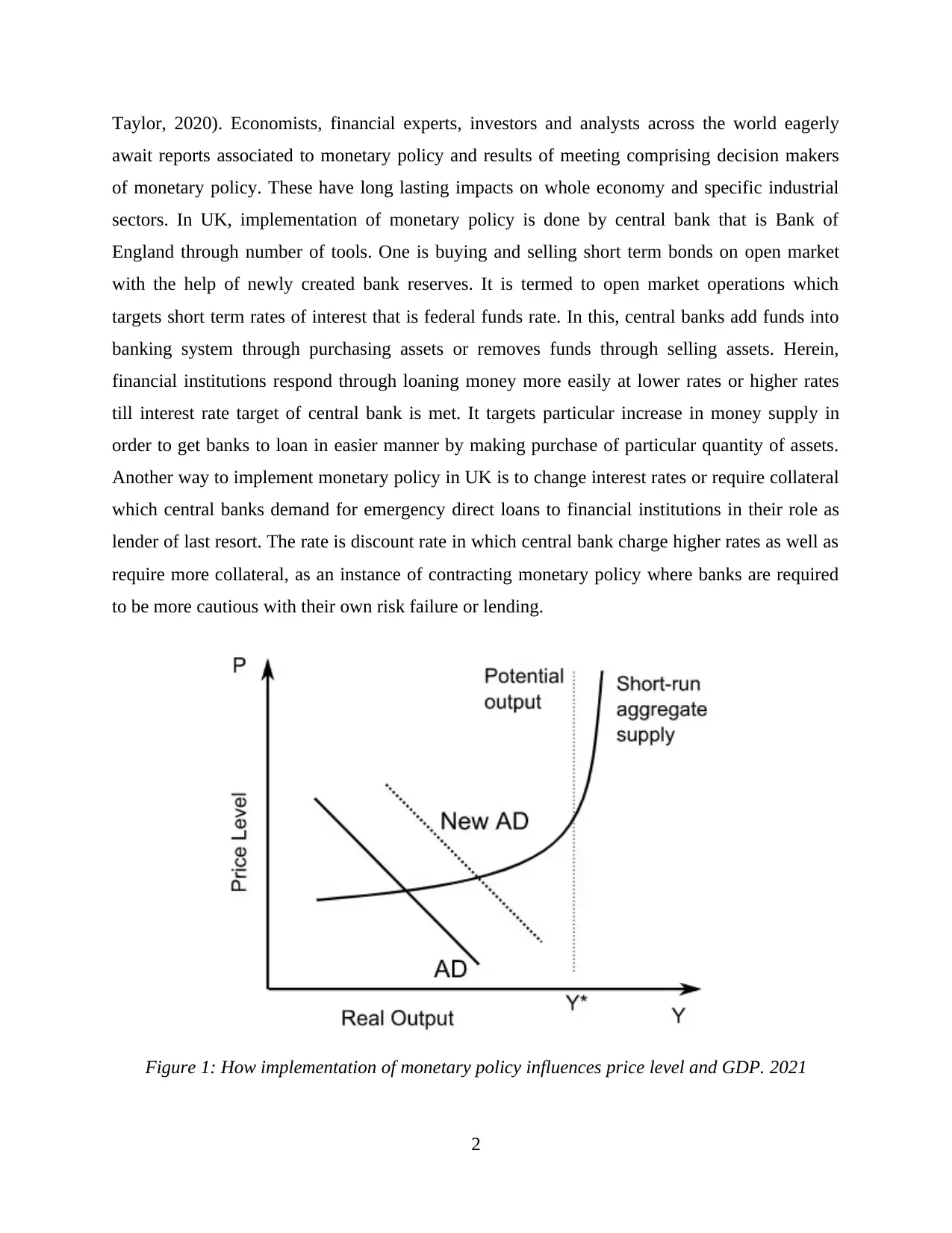
Taylor, 2020). Economists, financial experts, investors and analysts across the world eagerly
await reports associated to monetary policy and results of meeting comprising decision makers
of monetary policy. These have long lasting impacts on whole economy and specific industrial
sectors. In UK, implementation of monetary policy is done by central bank that is Bank of
England through number of tools. One is buying and selling short term bonds on open market
with the help of newly created bank reserves. It is termed to open market operations which
targets short term rates of interest that is federal funds rate. In this, central banks add funds into
banking system through purchasing assets or removes funds through selling assets. Herein,
financial institutions respond through loaning money more easily at lower rates or higher rates
till interest rate target of central bank is met. It targets particular increase in money supply in
order to get banks to loan in easier manner by making purchase of particular quantity of assets.
Another way to implement monetary policy in UK is to change interest rates or require collateral
which central banks demand for emergency direct loans to financial institutions in their role as
lender of last resort. The rate is discount rate in which central bank charge higher rates as well as
require more collateral, as an instance of contracting monetary policy where banks are required
to be more cautious with their own risk failure or lending.
Figure 1: How implementation of monetary policy influences price level and GDP. 2021
2
await reports associated to monetary policy and results of meeting comprising decision makers
of monetary policy. These have long lasting impacts on whole economy and specific industrial
sectors. In UK, implementation of monetary policy is done by central bank that is Bank of
England through number of tools. One is buying and selling short term bonds on open market
with the help of newly created bank reserves. It is termed to open market operations which
targets short term rates of interest that is federal funds rate. In this, central banks add funds into
banking system through purchasing assets or removes funds through selling assets. Herein,
financial institutions respond through loaning money more easily at lower rates or higher rates
till interest rate target of central bank is met. It targets particular increase in money supply in
order to get banks to loan in easier manner by making purchase of particular quantity of assets.
Another way to implement monetary policy in UK is to change interest rates or require collateral
which central banks demand for emergency direct loans to financial institutions in their role as
lender of last resort. The rate is discount rate in which central bank charge higher rates as well as
require more collateral, as an instance of contracting monetary policy where banks are required
to be more cautious with their own risk failure or lending.
Figure 1: How implementation of monetary policy influences price level and GDP. 2021
2
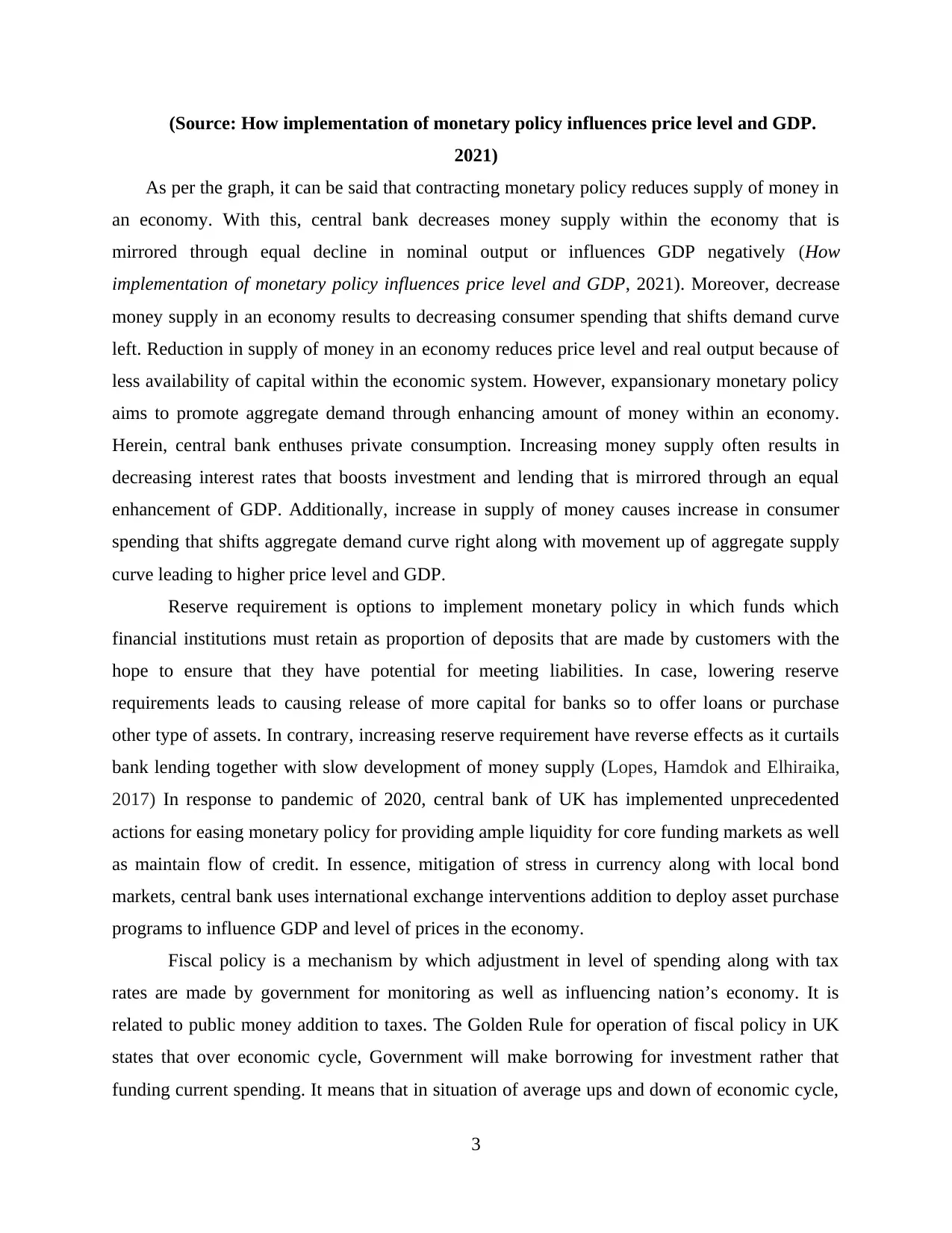
(Source: How implementation of monetary policy influences price level and GDP.
2021)
As per the graph, it can be said that contracting monetary policy reduces supply of money in
an economy. With this, central bank decreases money supply within the economy that is
mirrored through equal decline in nominal output or influences GDP negatively (How
implementation of monetary policy influences price level and GDP, 2021). Moreover, decrease
money supply in an economy results to decreasing consumer spending that shifts demand curve
left. Reduction in supply of money in an economy reduces price level and real output because of
less availability of capital within the economic system. However, expansionary monetary policy
aims to promote aggregate demand through enhancing amount of money within an economy.
Herein, central bank enthuses private consumption. Increasing money supply often results in
decreasing interest rates that boosts investment and lending that is mirrored through an equal
enhancement of GDP. Additionally, increase in supply of money causes increase in consumer
spending that shifts aggregate demand curve right along with movement up of aggregate supply
curve leading to higher price level and GDP.
Reserve requirement is options to implement monetary policy in which funds which
financial institutions must retain as proportion of deposits that are made by customers with the
hope to ensure that they have potential for meeting liabilities. In case, lowering reserve
requirements leads to causing release of more capital for banks so to offer loans or purchase
other type of assets. In contrary, increasing reserve requirement have reverse effects as it curtails
bank lending together with slow development of money supply (Lopes, Hamdok and Elhiraika,
2017) In response to pandemic of 2020, central bank of UK has implemented unprecedented
actions for easing monetary policy for providing ample liquidity for core funding markets as well
as maintain flow of credit. In essence, mitigation of stress in currency along with local bond
markets, central bank uses international exchange interventions addition to deploy asset purchase
programs to influence GDP and level of prices in the economy.
Fiscal policy is a mechanism by which adjustment in level of spending along with tax
rates are made by government for monitoring as well as influencing nation’s economy. It is
related to public money addition to taxes. The Golden Rule for operation of fiscal policy in UK
states that over economic cycle, Government will make borrowing for investment rather that
funding current spending. It means that in situation of average ups and down of economic cycle,
3
2021)
As per the graph, it can be said that contracting monetary policy reduces supply of money in
an economy. With this, central bank decreases money supply within the economy that is
mirrored through equal decline in nominal output or influences GDP negatively (How
implementation of monetary policy influences price level and GDP, 2021). Moreover, decrease
money supply in an economy results to decreasing consumer spending that shifts demand curve
left. Reduction in supply of money in an economy reduces price level and real output because of
less availability of capital within the economic system. However, expansionary monetary policy
aims to promote aggregate demand through enhancing amount of money within an economy.
Herein, central bank enthuses private consumption. Increasing money supply often results in
decreasing interest rates that boosts investment and lending that is mirrored through an equal
enhancement of GDP. Additionally, increase in supply of money causes increase in consumer
spending that shifts aggregate demand curve right along with movement up of aggregate supply
curve leading to higher price level and GDP.
Reserve requirement is options to implement monetary policy in which funds which
financial institutions must retain as proportion of deposits that are made by customers with the
hope to ensure that they have potential for meeting liabilities. In case, lowering reserve
requirements leads to causing release of more capital for banks so to offer loans or purchase
other type of assets. In contrary, increasing reserve requirement have reverse effects as it curtails
bank lending together with slow development of money supply (Lopes, Hamdok and Elhiraika,
2017) In response to pandemic of 2020, central bank of UK has implemented unprecedented
actions for easing monetary policy for providing ample liquidity for core funding markets as well
as maintain flow of credit. In essence, mitigation of stress in currency along with local bond
markets, central bank uses international exchange interventions addition to deploy asset purchase
programs to influence GDP and level of prices in the economy.
Fiscal policy is a mechanism by which adjustment in level of spending along with tax
rates are made by government for monitoring as well as influencing nation’s economy. It is
related to public money addition to taxes. The Golden Rule for operation of fiscal policy in UK
states that over economic cycle, Government will make borrowing for investment rather that
funding current spending. It means that in situation of average ups and down of economic cycle,
3
⊘ This is a preview!⊘
Do you want full access?
Subscribe today to unlock all pages.

Trusted by 1+ million students worldwide
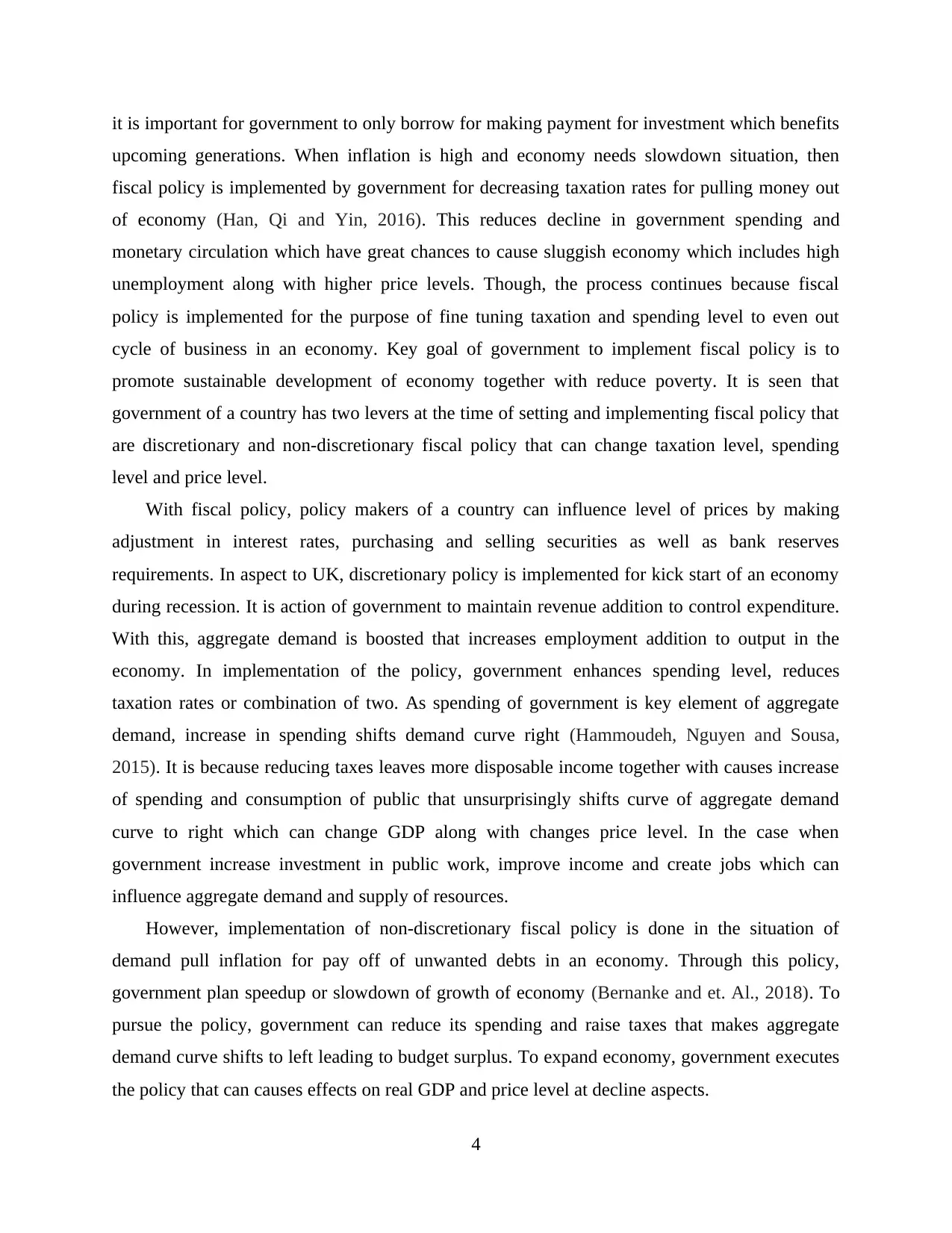
it is important for government to only borrow for making payment for investment which benefits
upcoming generations. When inflation is high and economy needs slowdown situation, then
fiscal policy is implemented by government for decreasing taxation rates for pulling money out
of economy (Han, Qi and Yin, 2016). This reduces decline in government spending and
monetary circulation which have great chances to cause sluggish economy which includes high
unemployment along with higher price levels. Though, the process continues because fiscal
policy is implemented for the purpose of fine tuning taxation and spending level to even out
cycle of business in an economy. Key goal of government to implement fiscal policy is to
promote sustainable development of economy together with reduce poverty. It is seen that
government of a country has two levers at the time of setting and implementing fiscal policy that
are discretionary and non-discretionary fiscal policy that can change taxation level, spending
level and price level.
With fiscal policy, policy makers of a country can influence level of prices by making
adjustment in interest rates, purchasing and selling securities as well as bank reserves
requirements. In aspect to UK, discretionary policy is implemented for kick start of an economy
during recession. It is action of government to maintain revenue addition to control expenditure.
With this, aggregate demand is boosted that increases employment addition to output in the
economy. In implementation of the policy, government enhances spending level, reduces
taxation rates or combination of two. As spending of government is key element of aggregate
demand, increase in spending shifts demand curve right (Hammoudeh, Nguyen and Sousa,
2015). It is because reducing taxes leaves more disposable income together with causes increase
of spending and consumption of public that unsurprisingly shifts curve of aggregate demand
curve to right which can change GDP along with changes price level. In the case when
government increase investment in public work, improve income and create jobs which can
influence aggregate demand and supply of resources.
However, implementation of non-discretionary fiscal policy is done in the situation of
demand pull inflation for pay off of unwanted debts in an economy. Through this policy,
government plan speedup or slowdown of growth of economy (Bernanke and et. Al., 2018). To
pursue the policy, government can reduce its spending and raise taxes that makes aggregate
demand curve shifts to left leading to budget surplus. To expand economy, government executes
the policy that can causes effects on real GDP and price level at decline aspects.
4
upcoming generations. When inflation is high and economy needs slowdown situation, then
fiscal policy is implemented by government for decreasing taxation rates for pulling money out
of economy (Han, Qi and Yin, 2016). This reduces decline in government spending and
monetary circulation which have great chances to cause sluggish economy which includes high
unemployment along with higher price levels. Though, the process continues because fiscal
policy is implemented for the purpose of fine tuning taxation and spending level to even out
cycle of business in an economy. Key goal of government to implement fiscal policy is to
promote sustainable development of economy together with reduce poverty. It is seen that
government of a country has two levers at the time of setting and implementing fiscal policy that
are discretionary and non-discretionary fiscal policy that can change taxation level, spending
level and price level.
With fiscal policy, policy makers of a country can influence level of prices by making
adjustment in interest rates, purchasing and selling securities as well as bank reserves
requirements. In aspect to UK, discretionary policy is implemented for kick start of an economy
during recession. It is action of government to maintain revenue addition to control expenditure.
With this, aggregate demand is boosted that increases employment addition to output in the
economy. In implementation of the policy, government enhances spending level, reduces
taxation rates or combination of two. As spending of government is key element of aggregate
demand, increase in spending shifts demand curve right (Hammoudeh, Nguyen and Sousa,
2015). It is because reducing taxes leaves more disposable income together with causes increase
of spending and consumption of public that unsurprisingly shifts curve of aggregate demand
curve to right which can change GDP along with changes price level. In the case when
government increase investment in public work, improve income and create jobs which can
influence aggregate demand and supply of resources.
However, implementation of non-discretionary fiscal policy is done in the situation of
demand pull inflation for pay off of unwanted debts in an economy. Through this policy,
government plan speedup or slowdown of growth of economy (Bernanke and et. Al., 2018). To
pursue the policy, government can reduce its spending and raise taxes that makes aggregate
demand curve shifts to left leading to budget surplus. To expand economy, government executes
the policy that can causes effects on real GDP and price level at decline aspects.
4
Paraphrase This Document
Need a fresh take? Get an instant paraphrase of this document with our AI Paraphraser
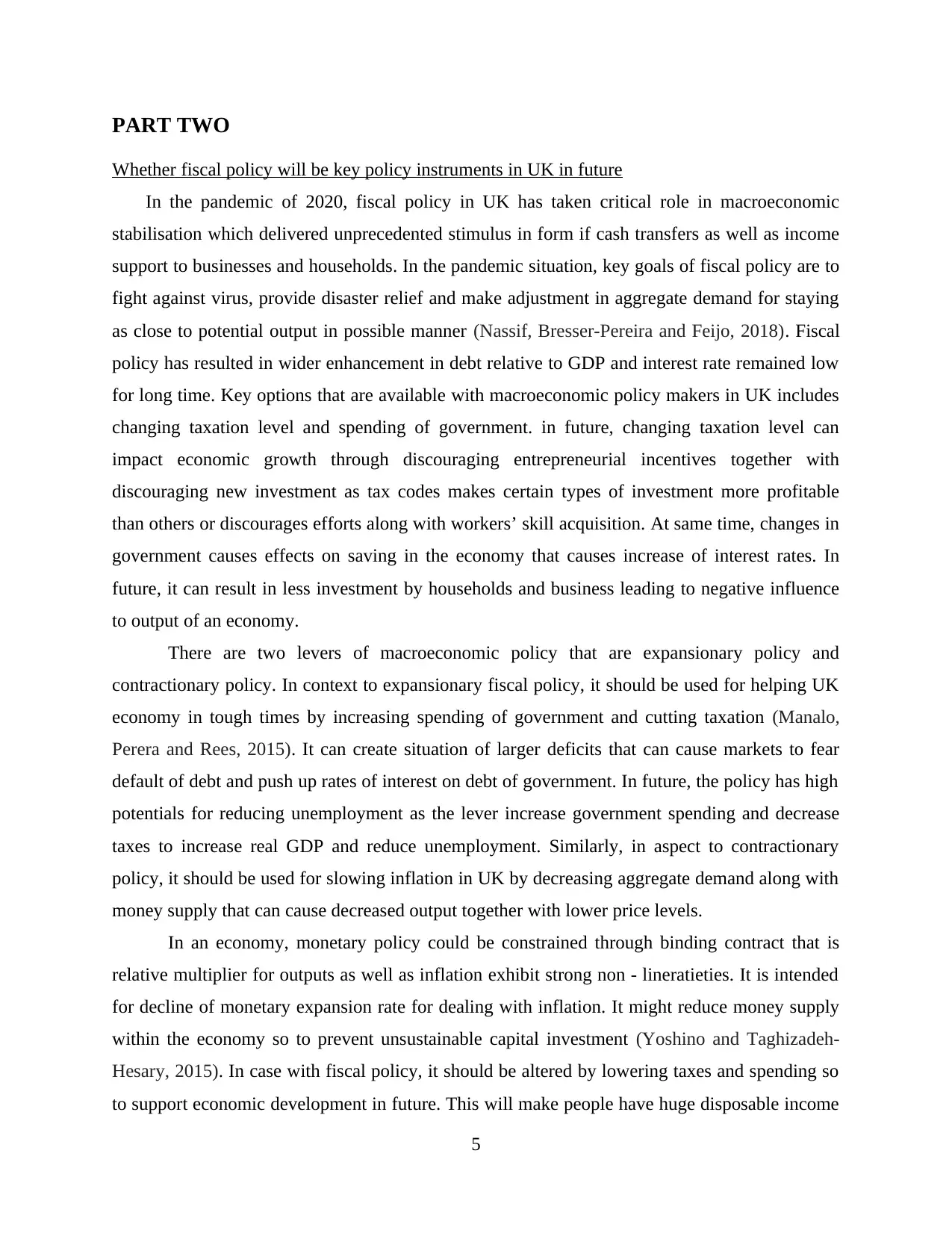
PART TWO
Whether fiscal policy will be key policy instruments in UK in future
In the pandemic of 2020, fiscal policy in UK has taken critical role in macroeconomic
stabilisation which delivered unprecedented stimulus in form if cash transfers as well as income
support to businesses and households. In the pandemic situation, key goals of fiscal policy are to
fight against virus, provide disaster relief and make adjustment in aggregate demand for staying
as close to potential output in possible manner (Nassif, Bresser-Pereira and Feijo, 2018). Fiscal
policy has resulted in wider enhancement in debt relative to GDP and interest rate remained low
for long time. Key options that are available with macroeconomic policy makers in UK includes
changing taxation level and spending of government. in future, changing taxation level can
impact economic growth through discouraging entrepreneurial incentives together with
discouraging new investment as tax codes makes certain types of investment more profitable
than others or discourages efforts along with workers’ skill acquisition. At same time, changes in
government causes effects on saving in the economy that causes increase of interest rates. In
future, it can result in less investment by households and business leading to negative influence
to output of an economy.
There are two levers of macroeconomic policy that are expansionary policy and
contractionary policy. In context to expansionary fiscal policy, it should be used for helping UK
economy in tough times by increasing spending of government and cutting taxation (Manalo,
Perera and Rees, 2015). It can create situation of larger deficits that can cause markets to fear
default of debt and push up rates of interest on debt of government. In future, the policy has high
potentials for reducing unemployment as the lever increase government spending and decrease
taxes to increase real GDP and reduce unemployment. Similarly, in aspect to contractionary
policy, it should be used for slowing inflation in UK by decreasing aggregate demand along with
money supply that can cause decreased output together with lower price levels.
In an economy, monetary policy could be constrained through binding contract that is
relative multiplier for outputs as well as inflation exhibit strong non - lineratieties. It is intended
for decline of monetary expansion rate for dealing with inflation. It might reduce money supply
within the economy so to prevent unsustainable capital investment (Yoshino and Taghizadeh-
Hesary, 2015). In case with fiscal policy, it should be altered by lowering taxes and spending so
to support economic development in future. This will make people have huge disposable income
5
Whether fiscal policy will be key policy instruments in UK in future
In the pandemic of 2020, fiscal policy in UK has taken critical role in macroeconomic
stabilisation which delivered unprecedented stimulus in form if cash transfers as well as income
support to businesses and households. In the pandemic situation, key goals of fiscal policy are to
fight against virus, provide disaster relief and make adjustment in aggregate demand for staying
as close to potential output in possible manner (Nassif, Bresser-Pereira and Feijo, 2018). Fiscal
policy has resulted in wider enhancement in debt relative to GDP and interest rate remained low
for long time. Key options that are available with macroeconomic policy makers in UK includes
changing taxation level and spending of government. in future, changing taxation level can
impact economic growth through discouraging entrepreneurial incentives together with
discouraging new investment as tax codes makes certain types of investment more profitable
than others or discourages efforts along with workers’ skill acquisition. At same time, changes in
government causes effects on saving in the economy that causes increase of interest rates. In
future, it can result in less investment by households and business leading to negative influence
to output of an economy.
There are two levers of macroeconomic policy that are expansionary policy and
contractionary policy. In context to expansionary fiscal policy, it should be used for helping UK
economy in tough times by increasing spending of government and cutting taxation (Manalo,
Perera and Rees, 2015). It can create situation of larger deficits that can cause markets to fear
default of debt and push up rates of interest on debt of government. In future, the policy has high
potentials for reducing unemployment as the lever increase government spending and decrease
taxes to increase real GDP and reduce unemployment. Similarly, in aspect to contractionary
policy, it should be used for slowing inflation in UK by decreasing aggregate demand along with
money supply that can cause decreased output together with lower price levels.
In an economy, monetary policy could be constrained through binding contract that is
relative multiplier for outputs as well as inflation exhibit strong non - lineratieties. It is intended
for decline of monetary expansion rate for dealing with inflation. It might reduce money supply
within the economy so to prevent unsustainable capital investment (Yoshino and Taghizadeh-
Hesary, 2015). In case with fiscal policy, it should be altered by lowering taxes and spending so
to support economic development in future. This will make people have huge disposable income
5

leading to increased demand for products. For meeting demand, government will spend to
organise resources for increasing production and create huge job opportunities. So, it can be said
that in Future, fiscal policy will be major policy instrument as it will boost aggregate demand
that in turn foster output together with employment opportunities in the economy of UK.
CONCLUSION
As per mentioned information, it is concluded that macroeconomic policy entails two pillars,
named as monetary and fiscal policy. Both these pillars are used for regularisation of economic
actions over time. These are often used for keeping growth of an economy stable with stable
prices, low inflation addition to low unemployment. Fiscal is about budget and comprises
government’s budget. In future, fiscal policy will comprise utilisation of spending, transfer
payments and taxation related to government for influencing GDP and price level for economic
growth.
6
organise resources for increasing production and create huge job opportunities. So, it can be said
that in Future, fiscal policy will be major policy instrument as it will boost aggregate demand
that in turn foster output together with employment opportunities in the economy of UK.
CONCLUSION
As per mentioned information, it is concluded that macroeconomic policy entails two pillars,
named as monetary and fiscal policy. Both these pillars are used for regularisation of economic
actions over time. These are often used for keeping growth of an economy stable with stable
prices, low inflation addition to low unemployment. Fiscal is about budget and comprises
government’s budget. In future, fiscal policy will comprise utilisation of spending, transfer
payments and taxation related to government for influencing GDP and price level for economic
growth.
6
⊘ This is a preview!⊘
Do you want full access?
Subscribe today to unlock all pages.

Trusted by 1+ million students worldwide
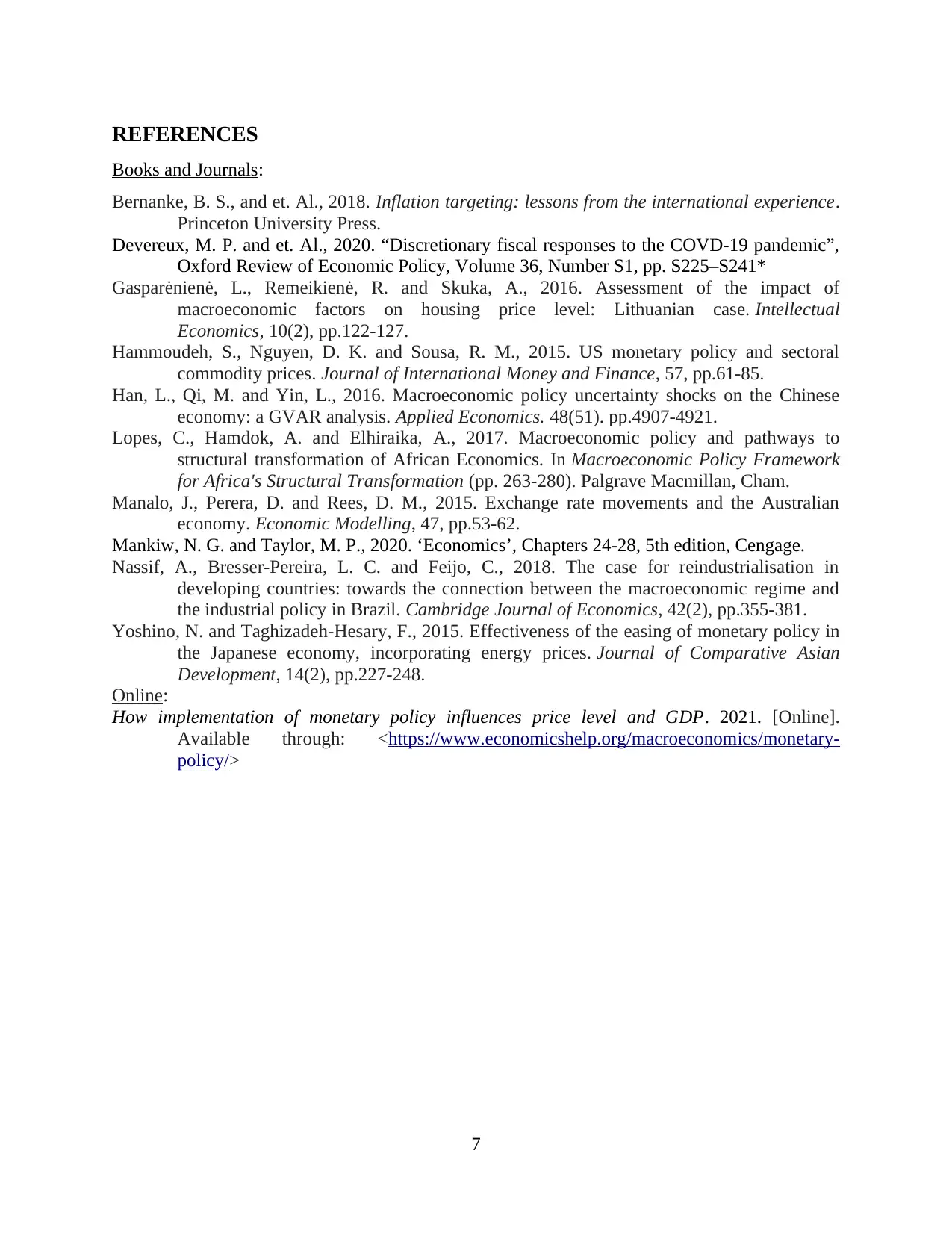
REFERENCES
Books and Journals:
Bernanke, B. S., and et. Al., 2018. Inflation targeting: lessons from the international experience.
Princeton University Press.
Devereux, M. P. and et. Al., 2020. “Discretionary fiscal responses to the COVD-19 pandemic”,
Oxford Review of Economic Policy, Volume 36, Number S1, pp. S225–S241*
Gasparėnienė, L., Remeikienė, R. and Skuka, A., 2016. Assessment of the impact of
macroeconomic factors on housing price level: Lithuanian case. Intellectual
Economics, 10(2), pp.122-127.
Hammoudeh, S., Nguyen, D. K. and Sousa, R. M., 2015. US monetary policy and sectoral
commodity prices. Journal of International Money and Finance, 57, pp.61-85.
Han, L., Qi, M. and Yin, L., 2016. Macroeconomic policy uncertainty shocks on the Chinese
economy: a GVAR analysis. Applied Economics. 48(51). pp.4907-4921.
Lopes, C., Hamdok, A. and Elhiraika, A., 2017. Macroeconomic policy and pathways to
structural transformation of African Economics. In Macroeconomic Policy Framework
for Africa's Structural Transformation (pp. 263-280). Palgrave Macmillan, Cham.
Manalo, J., Perera, D. and Rees, D. M., 2015. Exchange rate movements and the Australian
economy. Economic Modelling, 47, pp.53-62.
Mankiw, N. G. and Taylor, M. P., 2020. ‘Economics’, Chapters 24-28, 5th edition, Cengage.
Nassif, A., Bresser-Pereira, L. C. and Feijo, C., 2018. The case for reindustrialisation in
developing countries: towards the connection between the macroeconomic regime and
the industrial policy in Brazil. Cambridge Journal of Economics, 42(2), pp.355-381.
Yoshino, N. and Taghizadeh-Hesary, F., 2015. Effectiveness of the easing of monetary policy in
the Japanese economy, incorporating energy prices. Journal of Comparative Asian
Development, 14(2), pp.227-248.
Online:
How implementation of monetary policy influences price level and GDP. 2021. [Online].
Available through: <https://www.economicshelp.org/macroeconomics/monetary-
policy/>
7
Books and Journals:
Bernanke, B. S., and et. Al., 2018. Inflation targeting: lessons from the international experience.
Princeton University Press.
Devereux, M. P. and et. Al., 2020. “Discretionary fiscal responses to the COVD-19 pandemic”,
Oxford Review of Economic Policy, Volume 36, Number S1, pp. S225–S241*
Gasparėnienė, L., Remeikienė, R. and Skuka, A., 2016. Assessment of the impact of
macroeconomic factors on housing price level: Lithuanian case. Intellectual
Economics, 10(2), pp.122-127.
Hammoudeh, S., Nguyen, D. K. and Sousa, R. M., 2015. US monetary policy and sectoral
commodity prices. Journal of International Money and Finance, 57, pp.61-85.
Han, L., Qi, M. and Yin, L., 2016. Macroeconomic policy uncertainty shocks on the Chinese
economy: a GVAR analysis. Applied Economics. 48(51). pp.4907-4921.
Lopes, C., Hamdok, A. and Elhiraika, A., 2017. Macroeconomic policy and pathways to
structural transformation of African Economics. In Macroeconomic Policy Framework
for Africa's Structural Transformation (pp. 263-280). Palgrave Macmillan, Cham.
Manalo, J., Perera, D. and Rees, D. M., 2015. Exchange rate movements and the Australian
economy. Economic Modelling, 47, pp.53-62.
Mankiw, N. G. and Taylor, M. P., 2020. ‘Economics’, Chapters 24-28, 5th edition, Cengage.
Nassif, A., Bresser-Pereira, L. C. and Feijo, C., 2018. The case for reindustrialisation in
developing countries: towards the connection between the macroeconomic regime and
the industrial policy in Brazil. Cambridge Journal of Economics, 42(2), pp.355-381.
Yoshino, N. and Taghizadeh-Hesary, F., 2015. Effectiveness of the easing of monetary policy in
the Japanese economy, incorporating energy prices. Journal of Comparative Asian
Development, 14(2), pp.227-248.
Online:
How implementation of monetary policy influences price level and GDP. 2021. [Online].
Available through: <https://www.economicshelp.org/macroeconomics/monetary-
policy/>
7
1 out of 10
Related Documents
Your All-in-One AI-Powered Toolkit for Academic Success.
+13062052269
info@desklib.com
Available 24*7 on WhatsApp / Email
![[object Object]](/_next/static/media/star-bottom.7253800d.svg)
Unlock your academic potential
Copyright © 2020–2025 A2Z Services. All Rights Reserved. Developed and managed by ZUCOL.




